When it comes to efficient watering, choosing the right drip irrigation system can make a significant difference in your garden's health. You might be considering various options, but with the best systems of 2024 now available, it is crucial to weigh their unique features. Whether you prefer adjustable emitters for precision or durable components for long-lasting use, each system caters to specific needs. Curious about which systems stand out and how they can transform your watering routine? Let's explore the top five choices that could elevate your gardening experience.
CARPATHEN Drip Irrigation System – Adjustable Premium Irrigation Kit
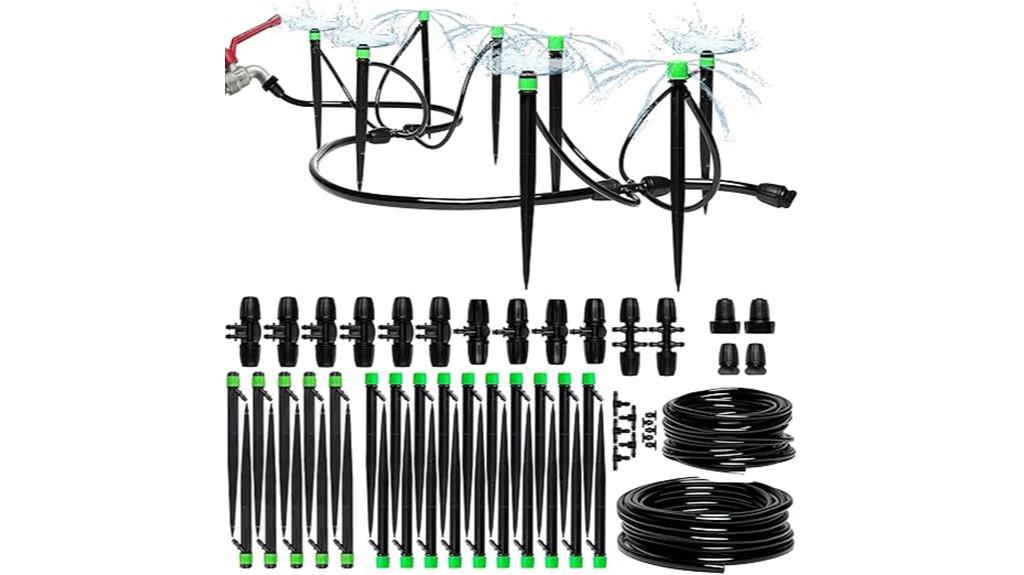
If you're a gardening enthusiast looking for an efficient way to keep your plants hydrated, the CARPATHEN Drip Irrigation System is an excellent choice. This adjustable premium kit comes with everything you need, including 10 vortex drip emitters and 20 spray emitters, allowing for precise hydration tailored to your garden's needs. Setting it up is a breeze with a simple 3/4" connection to your water source. I love how it minimizes water loss by targeting roots directly, effectively cutting down on my water bill. Plus, its UV-resistant materials guarantee durability, whether installed underground or above ground. The customer service is fantastic too, with quick resolutions and personal touches. Overall, it's a reliable choice for anyone serious about plant health.
Best For: Gardening enthusiasts looking for an efficient and customizable irrigation solution for their plants.
Pros:
- Easy installation with a straightforward 3/4" connection and flexible tubing options.
- Durable materials that are UV resistant, suitable for both underground and above-ground setups.
- Excellent customer service with quick resolutions and personal touches enhancing the buying experience.
Cons:





- Some users may require additional fittings for specific garden setups.
- The system's performance may be limited if water pressure falls below 20 PSI.
- Potential for clogging if emitters are not regularly cleaned, requiring maintenance.
HIRALIY 100ft Drip Irrigation Kit for Garden
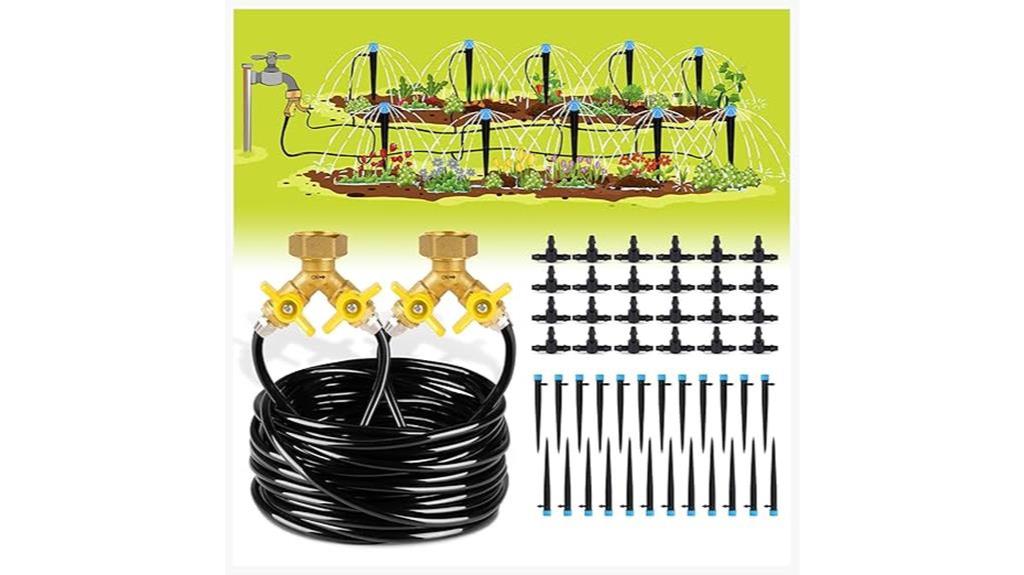
The HIRALIY 100ft Drip Irrigation Kit is an excellent choice for gardeners seeking a versatile and user-friendly solution for efficient watering. This kit includes 98.4 feet of black tubing, brass splitter adapters, Tee-connectors, and drip emitters, making it perfect for various applications like lawns and vegetable gardens. I found the installation straightforward, thanks to the user manual and video support. However, I did notice some users reported issues with hoses blowing off during hot weather, so it's wise to secure connections with hose clamps. The solid brass construction of the splitter guarantees durability, though the tubing might struggle with high pressure over time. Overall, it's a solid investment for automated watering, especially when paired with a timer.
Best For: Gardeners looking for an efficient, easy-to-install irrigation solution for various garden types, including lawns and vegetable patches.
Pros:
- Durable solid brass splitter ensures long-lasting use without rust.
- Simple installation with clear user manual and video support.
- Adjustable water flow options allow customization for different plants' needs.
Cons:
- Some users experienced hoses blowing off junctions, particularly in hot weather.
- Tubing may not withstand high water pressure over time, requiring careful monitoring.
- Price may be considered high by some, with potential post-purchase increases.
164FT Drip Irrigation Kit for Garden
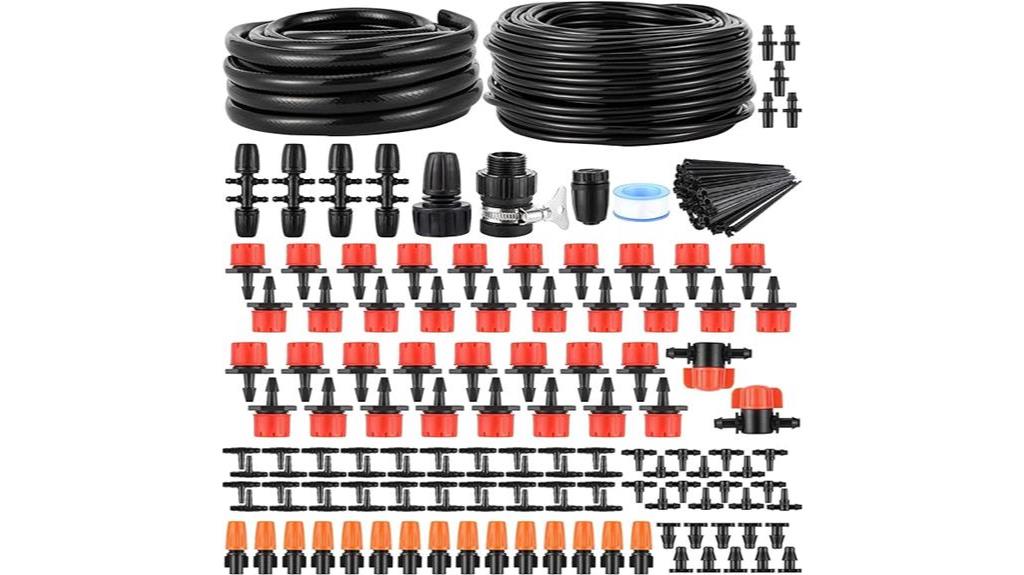
Looking to maximize your garden's potential? The FT Drip Irrigation Kit could be your solution. With 164 feet of tubing, this kit efficiently covers about 140 square feet of garden space. It includes 190 pieces, making installation straightforward, even for beginners—just soak the hose ends in hot water for easier fitting. I love that it can save up to 75% in water usage by delivering water directly to the roots. While some users note that assembly can be time-consuming, the result is well worth it. However, be aware that a pressure regulator may be necessary to prevent leaks. Overall, many find this kit a solid investment for both gardens and greenhouses. Happy watering!





Best For: Gardeners looking for an efficient and easy-to-install irrigation solution that conserves water while ensuring healthy plant growth.
Pros:
- Saves up to 75% in water usage by delivering water directly to root zones, reducing waste.
- Simple installation process with a manual and helpful tips, making it beginner-friendly.
- High-quality hoses and fittings that provide durability and effectiveness in various garden settings.
Cons:
- Assembly can be time-consuming, requiring patience and possibly grippy gloves for ease.
- Pressure regulator may be necessary to prevent leaks and bursts during operation.
- Mixed reviews on emitter functionality, with some users needing to make adjustments for optimal performance.
MIXC Drip Irrigation System Kit for Garden
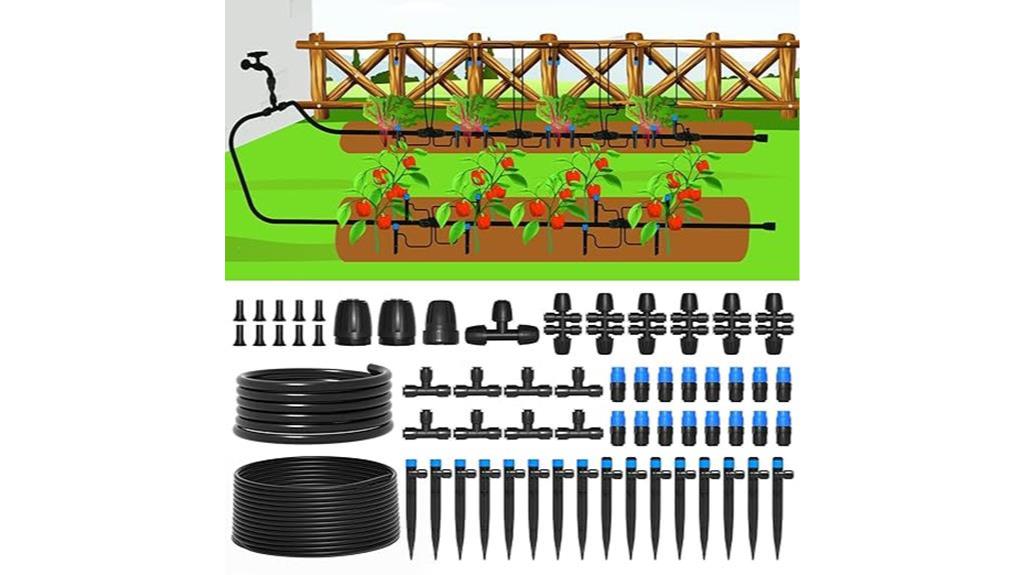
For anyone seeking an efficient way to keep their garden flourishing, the MIXC Drip Irrigation System Kit stands out with its user-friendly installation and extensive components. This 230FT kit includes everything from 197ft of 1/4-inch irrigation tube to vortex emitters and a Faucet Connector, ensuring I have all I need for my watering tasks. The Quick Connector Technology allows me to set it up in just 10 minutes, preventing leaks and making connections a breeze. I appreciate how the system can accommodate up to 32 emitters, allowing for precise watering tailored to different plants. It's versatile enough for my garden, lawn, and even greenhouse. Overall, I'm satisfied with its performance and the time it saves me.
Best For: Garden enthusiasts and homeowners looking for an efficient, easy-to-install irrigation solution for their plants and outdoor spaces.

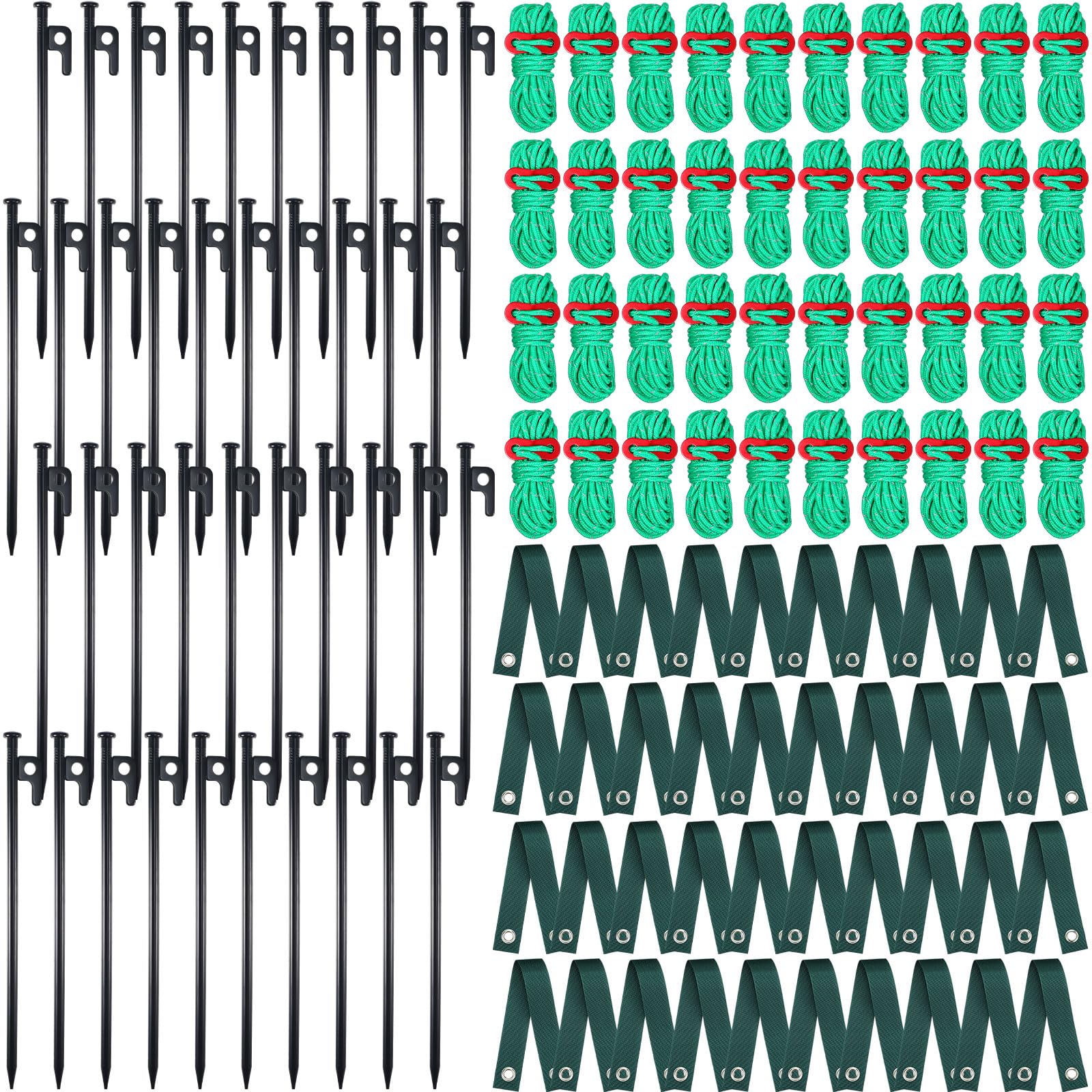



Pros:
- Easy and quick installation with Quick Connector Technology, taking only 10 minutes.
- Accommodates up to 32 emitters for tailored watering to different plant needs.
- Versatile application for various outdoor settings, including gardens, lawns, and greenhouses.
Cons:
- Connector reliability can be an issue under high pressure, potentially leading to leaks.
- Additional clamps may be needed for reinforcement to prevent movement of hoses.
- Some users may prefer higher quality hoses for improved performance.
240FT Drip Irrigation System Kit for Garden and Lawn
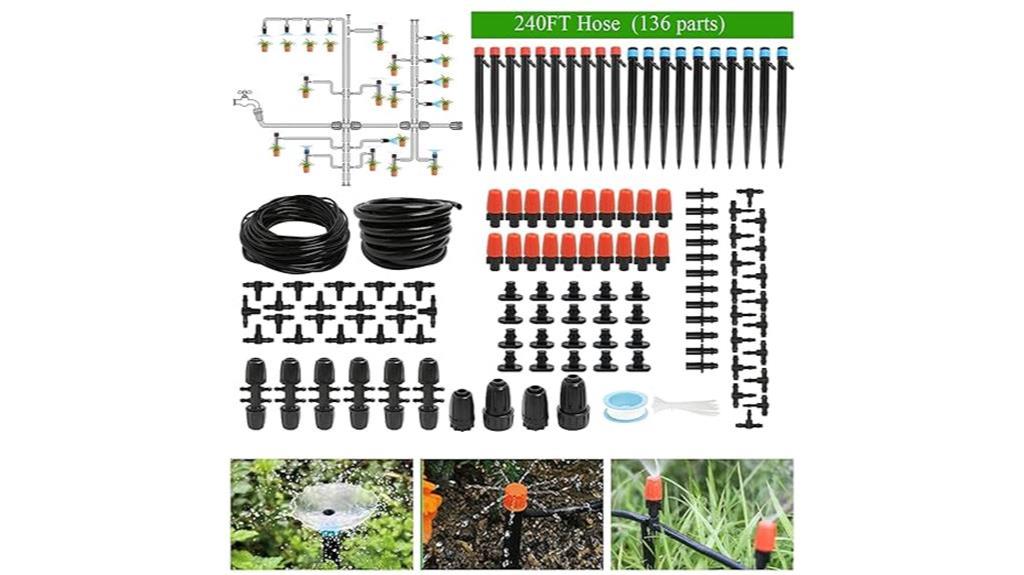
If you're a garden enthusiast seeking an efficient way to keep your plants hydrated, the 240FT Drip Irrigation System Kit is an ideal choice. This kit features 40FT of main tubing and 200FT of distribution tubing, giving you the flexibility to create two small systems or one larger setup. With a total of 136 components, it can cover up to 250 square feet, perfect for flowers and trees alike. The upgraded 1/2 inch main tubing handles high water pressure, while three types of sprayers enhance watering efficiency, providing up to 80% water savings. Installation is straightforward, but I recommend using hot water to ease the 1/4 inch tubing fittings. Overall, it's a solid investment for efficient garden care.
Best For: Garden enthusiasts looking for an efficient and flexible irrigation solution for their plants and flowers.
Pros:
- Water Efficiency: Provides up to 80% water savings, making it eco-friendly.
- Customizable Setup: Allows for the creation of two smaller systems or one larger system based on your garden layout.
- Straightforward Installation: Comes with an instruction manual and easy-to-follow setup tips.
Cons:
- Durability Concerns: Some users have reported issues with the durability of the 1/2 inch tubing.
- Hose Connection Limitations: Non-swivel hose connections may lead to difficulties in adjusting the system.
- Component Availability: Lack of option to purchase individual components may limit customization for some users.
Factors to Consider When Choosing Drip Irrigation Systems
When choosing a drip irrigation system, you need to take into account several key factors. Think about the size requirements of your garden, the compatibility with your water pressure, and how complex the installation will be. Also, evaluate the durability of the materials used and the system's efficiency in water usage to guarantee you make the right choice.
System Size Requirements
Choosing the right size for your drip irrigation system is essential to guarantee efficient watering and healthy plant growth. Start by determining the total area that needs irrigation. For instance, a 164FT drip irrigation kit covers about 140 square feet, while a 240FT kit accommodates up to 250 square feet or two separate 120 square feet areas.
Next, assess how many plants or emitter points you need. Most systems have a maximum number of emitters along the tubing, which can impact water distribution and efficiency. Be mindful of the length of the main and distribution tubing, as kits can vary considerably; some offer up to 230FT for expansive coverage.
Evaluate the components included in the kit, like emitters and connectors, to ascertain they fit your specific setup for effective watering. Finally, make sure the system can support your desired watering method. Different kits offer various emitter types—like drip, spray, or mist—each catering to different plant needs. By considering these factors, you'll set yourself up for a successful watering experience that nourishes your garden.
Water Pressure Compatibility
Understanding water pressure compatibility is vital for guaranteeing your drip irrigation system operates efficiently. Most drip irrigation systems work best within a pressure range of 20-45 PSI, with some high-performance models able to handle greater pressures. If you're using a low flow system, keep in mind that it can be sensitive to water pressure changes, requiring you to adjust the faucet to maintain proper spray patterns and emitter functionality.
The number of emitters connected per water line also impacts pressure. You might need to limit emitters to around six per line to prevent reduced flow. High water pressure can cause hoses to blow off junctions or lead to emitter malfunctions, which means you should consider using pressure regulators or clamps to secure connections effectively.
Lastly, verify your chosen system is compatible with your existing water sources and pressure levels. This compatibility is vital for the efficient operation and longevity of your drip irrigation system, helping you avoid costly repairs and guaranteeing that your plants receive the right amount of water consistently.
Installation Complexity Level
Installing a drip irrigation system can range from a straightforward task to a complex project, depending on the kit you select. Some systems are designed for quick setup, featuring quick connector technology that minimizes the need for tools and time. If you're new to plumbing, look for kits with detailed instruction manuals that include visual aids or QR codes linking to installation videos. These resources can make the process much easier.
The type of tubing you choose can also affect installation complexity. Certain materials may require you to heat the ends for proper fitting connections, which can add to your setup time. Systems with pre-assembled components or simpler connections typically demand less effort compared to those that require extensive assembly or customization.
Durability and Material Quality
The longevity and performance of your drip irrigation system largely depend on the quality of materials used in its construction. When you're selecting a system, you should prioritize UV-resistant materials, as these can endure exposure to sunlight without degrading over time. This resistance is vital for maintaining the system's efficiency and extending its lifespan.
Also, opt for solid brass connectors. They guarantee durability and prevent rust, which can lead to leaks and reduced performance overall. Systems featuring detachable emitter heads are particularly beneficial; they allow for easy cleaning, preventing clogging and further extending the life of your components.
Don't overlook the tubing, either. Choose tubing that can handle various water pressures, as higher quality options should withstand pressure fluctuations without bursting or leaking. Finally, take some time to evaluate customer feedback on material longevity. User experiences can reveal potential durability issues under different environmental conditions, helping you make a more informed choice.
Efficiency in Water Usage
When it comes to maximizing water efficiency, drip irrigation systems stand out by delivering water directly to the roots of your plants. This targeted approach can save you up to 75% in water usage compared to traditional watering methods, considerably reducing evaporation and runoff.
To guarantee your system operates efficiently, it's vital to maintain the pressure within the recommended range of 20-45 PSI. This pressure is important for proper water distribution and the functionality of emitters. Additionally, adjustable emitters allow you to customize water flow rates, catering to the unique hydration needs of different plants and soil types.
By hydrating roots directly, you minimize water loss and promote healthier plants, all while consuming less water overall. Regular maintenance—such as cleaning detachable emitter heads—helps prevent clogging and guarantees ideal water flow, further enhancing your system's efficiency.
When choosing a drip irrigation system, focus on these factors to maximize water usage and support sustainable gardening practices. By investing in a reliable, efficient system, you'll not only conserve water but also foster a thriving garden environment.
Versatility for Applications
Drip irrigation systems offer remarkable versatility, making them suitable for a variety of gardening and agricultural applications. Whether you're tending to vegetable gardens, flower beds, greenhouses, patios, lawns, or expansive agricultural fields, these systems adapt seamlessly to different plant types and growing conditions.
Many drip irrigation kits are designed for both above-ground and underground installations, providing you the flexibility to optimize your garden layout and space. With adjustable emitters, you can tailor hydration to meet the specific needs of various plant species, ensuring each plant gets just the right amount of water.
You can also connect multiple emitters and various tubing types, allowing for customized configurations that cater to everything from small raised beds to larger garden areas. Plus, certain systems work well with existing irrigation setups and timers, enhancing their versatility and making integration into your current gardening practices a breeze.
When selecting a drip irrigation system, consider how well it can adapt to your unique gardening situation, so you can achieve the most efficient and effective watering.
Frequently Asked Questions
What Is the Average Lifespan of a Drip Irrigation System?
The average lifespan of a drip irrigation system usually ranges from 5 to 15 years, depending on factors like materials, maintenance, and usage. If you regularly check for clogs, leaks, and wear, you can extend its life. Choosing high-quality components and installing them correctly also makes a big difference. Remember, regular maintenance not only keeps your system running efficiently but can save you money in the long run by preventing costly repairs or replacements.
Can I Install a Drip Irrigation System Myself?
Yes, you can install a drip irrigation system yourself! With a little planning and the right tools, it's totally doable. Start by mapping out your garden and determining where the plants are. Then, gather all necessary materials, like tubing, emitters, and connectors. Follow the instructions provided with your system, and don't hesitate to watch tutorial videos for guidance. You'll save money and gain satisfaction from creating an efficient watering solution for your plants!
How Often Should I Check My Drip Irrigation System?
You might think once a month is enough, but checking your drip irrigation system more frequently is wise. Ideally, inspect it weekly, especially during peak growing seasons. Look for leaks, clogs, and proper coverage. If you notice any issues, tackle them right away to prevent water waste and guarantee your plants receive adequate hydration. Regular checks keep your system running smoothly and help you catch problems before they escalate.
Are Drip Irrigation Systems Suitable for All Types of Plants?
Drip irrigation systems are suitable for most types of plants, but they work best for those that require consistent moisture, like vegetables and flowers. You'll find they're especially effective for drought-tolerant plants, as you can control the water flow precisely. However, some larger trees or deep-rooted plants might need additional watering methods. Always consider your specific plants' needs and adjust your system accordingly to guarantee ideal growth and health.
What Maintenance Is Required for a Drip Irrigation System?
Maintaining your drip irrigation system isn't rocket science, but it does require some diligence. You'll need to regularly check for clogs in emitters and flush the lines to keep everything flowing smoothly. Inspect the tubing for leaks or damage, and adjust the system seasonally to match your plants' needs. Additionally, you should clean filters and guarantee that your water source is free from debris. With a bit of care, your system will thrive!
Wrapping Up
To sum up, choosing the right drip irrigation system can transform your gardening experience. Did you know that drip irrigation can reduce water usage by up to 50% compared to traditional methods? By selecting one of the top systems of 2024, you'll not only save water but also guarantee your plants receive the precise hydration they need. Embrace efficiency and versatility in your garden—your plants will thank you for it!
